
The H.C. Pitney Variety Store Building is a commercial building in downtown Tampico, Illinois, United States, constructed in 1900. The building is part of a two-story commercial block along Main Street.

The Liberty Building is a historic building located in downtown Des Moines, Iowa, United States. It has been a downtown landmark since 1923. The Liberty Building is located at the SW corner of 6th Avenue and Grand Avenue in the heart of downtown Des Moines. The building was originally home to Bankers Life Insurance & WHO (AM) Radio. Designed by the prominent Des Moines architectural firm of Proudfoot, Bird & Rawson, the 12-story building rises to a height of 174 feet (53 m).
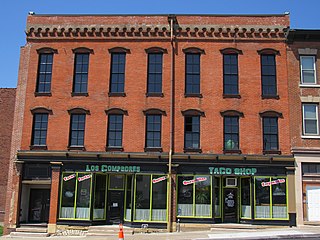
The Wupperman Block/I.O.O.F. Hall is a historic building located just north of downtown Davenport, Iowa, United States. It was individually listed on the National Register of Historic Places in 1983. In 2020 it was included as a contributing property in the Davenport Downtown Commercial Historic District.

The Baker-Devotie-Hollingsworth Block is a historic building located in the East Village of Des Moines, Iowa, United States. The eastern two-thirds of the block was listed on the National Register of Historic Places in 1978 as the Studio Building. The western one-third was added to the National Register in 2008, and its name was changed at that time. In 2019 the entire building was included as a contributing property in the East Des Moines Commercial Historic District.
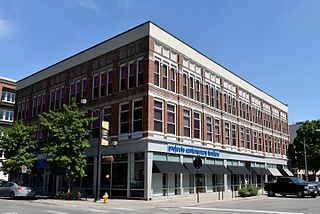
The Syndicate Block, also known as the McCoy Building, is an historic building located in the East Village of Des Moines, Iowa, United States. It was individually listed on the National Register of Historic Places in 2001. In 2019 the building was included as a contributing property in the East Des Moines Commercial Historic District.
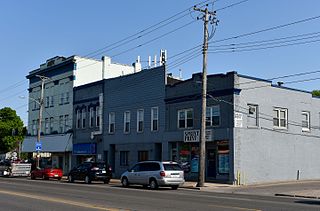
The College Corner Commercial Historic Business District, also known as the Highland Park Historic Business District at Euclid and Second, is located in the north-central section of Des Moines, Iowa, United States. It is located in the Highland Park neighborhood that also includes the Highland Park Historic Business District at Euclid and Sixth Avenues. The College Corner historic district has been listed on the National Register of Historic Places since 1998.
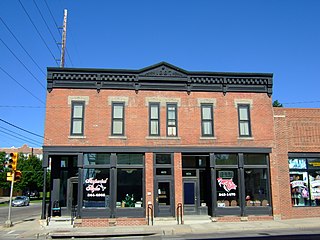
The Wherry Block, also known as Wherry's Hall, Scruby Brothers Grocery, and Scruby's Grocery Store, is a historic building located in Des Moines, Iowa, United States.

The Sixth and Forest Historic District is located in Des Moines, Iowa, United States. It is a Victorian era suburban commercial district on the northeastern and northwestern corners of the junction of 6th and Forest Avenues, and originally contained six buildings. The buildings on the northeast corner have subsequently been torn down. The historic district has been listed on the National Register of Historic Places since 1996. It is a part of the Towards a Greater Des Moines MPS.

Youngerman Block is a three-story commercial building in downtown building in Des Moines, Iowa, incorporating Italianate architecture, with later alterations that introduced Art Deco detailing. Built in 1876, the Youngerman Block was designed by architect William Foster (1842-1909) for Conrad Youngerman.
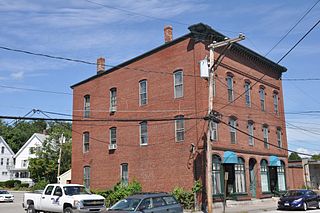
The Jacob Noyes Block is a historic commercial building at 48 Glass Street in the Pembroke side of Suncook, New Hampshire. Built about 1865, it is a distinctive local example of Italianate commercial architecture, and is the largest 19th-century commercial building in the village. It was listed on the National Register of Historic Places in 1986.

The Progressive Market is a historic commercial building at 63 South Main Street in White River Junction, Vermont. Built in 1922, it is an example of an increasingly rare type of building in Vermont, the neighborhood market. The store was operated for many years by Italian immigrants and Italian Americans, serving a local community in the area south of downtown White River Junction. The building, largely vernacular in form, was listed on the National Register of Historic Places in 1995. it appears to no longer house a retail establishment.
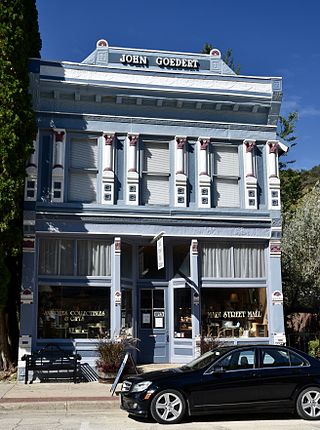
The Goedert Meat Market, also known as the Main Street Mall, is a historic building located in McGregor, Iowa, United States. The two-story, single-unit, brick building was completed in 1890 in the Italianate style. It maintains the only complete cast-iron storefront in town. The storefront was manufactured by Mesker Bros. Front Builders of St. Louis, Missouri. The facility dates from the time when all aspects of the meat business from slaughter, to processing, to sales were housed in one building. The New York-style meat market was built for John Goedert, who maintained his residence upstairs. By the turn of the 20th-century it housed Bergman's deli/butcher shop, and remained a butcher shop until 1944. The building was individually listed on the National Register of Historic Places (NRHP) in 1996. In 2002 it was listed as a contributing property in the McGregor Commercial Historic District.

The Mills Tower Historic District is a nationally recognized historic district located in Iowa Falls, Iowa, United States. It was listed on the National Register of Historic Places in 1990. At the time of its nomination the district consisted of six resources, including two contributing buildings, and four non-contributing buildings. All of the buildings are associated with the Illinois Central Railroad (IC). The Dubuque & Sioux City Railroad, an affiliate of the IC, laid the first rail track to Iowa Falls in 1866. The following year the Iowa Falls & Sioux City Railroad, another IC affiliate, continued construction of the line to the west, and it reached Sioux City by 1870. The Burlington, Cedar Rapids and Northern Railway (BCR&N) by way of its affiliate the Cedar Rapids, Iowa Falls & North Western, entered Iowa Falls in 1880. Two years later it was expanded to the north and intersected with the IC main line, which required a controlled crossing. Little is known about this first crossing and what it contained.

The Valley Junction-West Des Moines City Hall and Engine House is a historic building located in West Des Moines, Iowa, United States. Valley Junction was incorporated in 1893, and it was named for the junction of three lines of the Chicago, Rock Island and Pacific Railroad where it was located. This two-story brick building was constructed to house the community's city hall and fire station, even though the fire department would not be established until 1905. The fire station was located on the first floor, and the city hall was located on the second floor. It was located a block north of the train depot. An interurban railway connected the town to Des Moines, and its proximity to the Iowa coal fields contributed to its growth. By 1911 the town grew to be the second largest community in Polk County, and its name was changed to West Des Moines by 1940. The building was used for city hall until 1952. It was individually listed on the National Register of Historic Places in 1983. It was included as a contributing property in the Valley Junction Commercial Historic District in 2017.
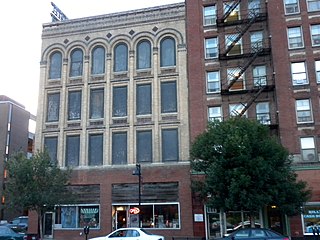
The Earle & LeBosquet Block, also known as the Redhead & Wellslager Block, is a historic building located in Des Moines, Iowa, United States. Completed in 1896, the building is a fine example of the work of Des Moines architect Charles E. Eastman. It shows Eastman's ability to use Neoclassical forms and integrate the more modern Chicago Commercial style. It is also an early use of terra cotta for architectural detailing and buff-colored brick for the main facade in Des Moines, which became widespread in the city in the following decades. The main floor housed two commercial spaces and the upper floors were used for warehouse space. The four-story structure was built by local contractor Gerrit Van Ginkel, and it was owned by attorneys Ira M. Earle and Peter S. LeBosquet. It replaced a three-story brick building that was built at this location in 1876. The building was listed on the National Register of Historic Places in 2009.

The Homestead Building, also known as the Martin Hotel, is a historic building located in Des Moines, Iowa, United States. Designed by the Des Moines architectural firm of Smith & Gage, it was built in two stages. The eastern one-third was completed in 1893 and the western two-thirds was completed in 1905. It is one of a few late nineteenth-century commercial/industrial buildings that remain in the downtown area. The building was built for James M. Pierce for his publishing operation, which included the Iowa Homestead, a pioneer publication of modern agricultural journalism. Prior to Pierce, the Iowa Homestead publisher was Henry Wallace, the father of Agriculture Secretary Henry C. Wallace, and grandfather of U.S. Vice President Henry A. Wallace. "Through the efforts of Pierce and Wallace the Iowa Homestead became known for its promotion of the rotation of crops, the use of better seed, the value of more and better livestock, the importance of an attractive home and a good home life, the value of farmers banding together to protect common interests, and the care of the soil and conservation of its resources."
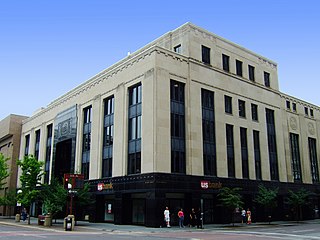
The Iowa-Des Moines National Bank Building, also known as the Valley National Bank Building and U.S. Bank, is a historic building located in downtown Des Moines, Iowa, United States. Designed by the prominent Des Moines architectural firm of Proudfoot, Rawson, Souers & Thomas, it was designed to be a 21- or 22-story building. It is one of the few downtown commercial buildings built in the Art Deco style. It is also thought to be one of the first bank buildings to put the banking room on the second floor while placing retail space on the first floor. Given its location in an area dominated by retail this made sense. This location had a bank on it since 1882 when the Des Moines National Bank built here. The present building was the result when Des Moines National Bank merged with Iowa National Bank and Des Moines Savings Bank and Trust Company in 1929. The original design for the building was a five-story base and a set-back rental office tower on top of it. The base was begun in 1931 and completed a year later. The building is composed of black polished granite on the first floor and the upper floors are Bedford stone. There is a recessed entrance in the center bay of the main facade. The fifth floor was meant to be the base of the office tower that was never built.

The Masonic Temple, also known as the A.F. & A.M. Hall, Masonic Building, Greeley Building, and the Octagon Center for the Arts, is a historic building located in Ames, Iowa, United States. Built between 1916 and 1917, the three-story, brick, Neoclassical building was designed by the Des Moines architectural firm of Liebbe, Nourse & Rasmussen. It was commissioned by Wallace M. Greeley, an Ames banker and civic leader. The building was built at the high point of Progressive era construction in the central business district, and with several other noteworthy public and semi-public buildings, marked Ames' transition from a rural town to a modern city. Arcadia Lodge #249 occupied the third floor of the building from its completion in 1917 to 1997, when they built a new building on Alexander Avenue.

Ames Main Street Historic District is a nationally recognized historic district located in Ames, Iowa, United States. It was listed on the National Register of Historic Places in 2018. At the time of its nomination it included 81 resources as well as 15 non-contributing buildings. The district covers most of the city's central business district. The area began to develop after the Civil War along the Chicago and North Western (CNW) tracks. The district was also served by the Ames & College Railway and its successor, the Fort Dodge, Des Moines, & Southern Interurban Streetcar line, from 1891 to 1929. The later connected downtown Ames and the CNW depot with Iowa State College, now known as Iowa State University.

The Valley Junction Commercial Historic District is a nationally recognized historic district located in West Des Moines, Iowa, United States. It was listed on the National Register of Historic Places in 2017. At the time of its nomination it consisted of 72 resources, which included 53 contributing buildings, 17 non-contributing buildings, and two non-contributing structures. What is now the city of West Des Moines was incorporated as Valley Junction in 1893. Its central business district, which is the subject of this historic district, developed near the depot of the Chicago, Rock Island and Pacific Railroad. The railroad also had their shops (non-extant) to the southwest of the district in an angle formed by the junction. The linear historic district is composed of most of three blocks of Fifth Street and parts of two cross streets.























